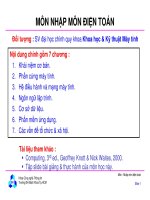Communications and networks (NHẬP môn điện TOÁN SLIDE)
Bạn đang xem bản rút gọn của tài liệu. Xem và tải ngay bản đầy đủ của tài liệu tại đây (2.02 MB, 30 trang )
Chapter 9
Communications and
Networks
McGraw-Hill
Copyright © 2012 The McGraw-Hill Companies, Inc. All rights
reserved.
Computing Essentials 2012: Making IT Work for You
Introduction
• We live in a truly connected society.
• Increased connectivity potentially
means increased productivity,
especially in business.
• You will learn more about the
concept of connectivity and
the impact of the wireless
revolution in this chapter.
McGraw-Hill
Copyright © 2012 The McGraw-Hill Companies, Inc. All rights
reserved.
9-2
Computing Essentials 2012: Making IT Work for You
Communications
• Computer communications is the process
of sharing data, programs, and
information between two or more
computers
• Numerous applications depend on
communication systems, including
–
–
–
–
–
McGraw-Hill
Instant messaging
Internet telephone
Electronic commerce
Global positioning systems (GPS)
Copyright © 2012 The McGraw-Hill Companies, Inc. All rights
reserved.
9-3
Computing Essentials 2012: Making IT Work for You
Communications Today
• Connectivity uses computer networks
to link people and resources
• The Wireless Revolution
– Single most dramatic change in
connectivity and communications
has been widespread use of mobile
telephones with wireless Internet
connectivity
McGraw-Hill
Copyright © 2012 The McGraw-Hill Companies, Inc. All rights
reserved.
9-4
Computing Essentials 2012: Making IT Work for You
Communication
Systems
• Four
basic elements
–
–
–
–
McGraw-Hill
Sending and receiving devices
Communication channel
Connection devices
Data transmission specifications
Copyright © 2012 The McGraw-Hill Companies, Inc. All rights
reserved.
9-5
Computing Essentials 2012: Making IT Work for You
Communication
Channels
• Communication channels carry the
data from one computer to another
• Two categories of communication
channels
– Physical connection
– Wireless connection
McGraw-Hill
Copyright © 2012 The McGraw-Hill Companies, Inc. All rights
reserved.
9-6
Computing Essentials 2012: Making IT Work for You
Physical Connections
• Ethernet cable
(Twisted pair cable)
ã Coaxial cable
ã Fiber-optic cable
McGraw-Hill
Return
Copyright â 2012 The McGraw-Hill Companies, Inc. All rights
reserved.
9-7
Computing Essentials 2012: Making IT Work for You
Wireless Connections
• Radio frequency (RF)
– Wi-Fi (wireless fidelity)
– Bluetooth (short-range)
– WiMax (extends Wi-Fi)
• Microwave
• Satellite
– Global positioning system (GPS)
• Infrared
– Short distances and line of sight
McGraw-Hill
Copyright © 2012 The McGraw-Hill Companies, Inc. All rights
reserved.
9-8
Computing Essentials 2012: Making IT Work for You
McGraw-Hill
Communication Channels
Summary
Copyright © 2012 The McGraw-Hill Companies, Inc. All rights
reserved.
9-9
Computing Essentials 2012: Making IT Work for You
Connection Device
Signals
• Types
of signals
– Analog
– Digital
McGraw-Hill
Copyright © 2012 The McGraw-Hill Companies, Inc. All rights
reserved.
9-10
Computing Essentials 2012: Making IT Work for You
Connection Devices
• Types of modems
– Telephone modem
– DSL
(digital subscriber line)
– Cable modem
– Wireless modem
(WWAN)
McGraw-Hill
Copyright © 2012 The McGraw-Hill Companies, Inc. All rights
reserved.
9-11
Computing Essentials 2012: Making IT Work for You
Connection Services
• Dial-Up services
– Uses phone lines
• Leased lines
– Replaced by
optical carrier
(OC) lines
• Digital
subscriber line
(DSL)
– Uses phone lines
– ADSL is most
widely used type
of DSL
McGraw-Hill
• Cable
– Uses existing TV
cable
– Speeds as fast as DSL
• Satellite connection
services
– Use almost anywhere
– Slower than DSL and
cable modem
• Cellular Services
– Use 3G and 4G
cellular network to
provide wireless
connectivity
Copyright © 2012 The McGraw-Hill Companies, Inc. All rights
reserved.
9-12
Computing Essentials 2012: Making IT Work for You
Connection Costs and
Speeds
• Typical user connection costs,
bandwidth speeds, and comparable
time required to download an image
in the USA
McGraw-Hill
Copyright © 2012 The McGraw-Hill Companies, Inc. All rights
reserved.
9-13
Computing Essentials 2012: Making IT Work for You
Bandwidth
• Measurement of the width or capacity
of the communication channel
• Categories
– Voice band (or low bandwidth)
– Medium band
– Broadband
– Baseband
McGraw-Hill
Copyright © 2012 The McGraw-Hill Companies, Inc. All rights
reserved.
9-14
Computing Essentials 2012: Making IT Work for You
Protocols
• Communication rules for exchanging
data between computers
• Internet standard: TCP/IP
(Transmission control
protocol/Internet protocol)
– Identification – unique IP address
– Packetization – broken down and
reassembled
McGraw-Hill
Copyright © 2012 The McGraw-Hill Companies, Inc. All rights
reserved.
9-15
Computing Essentials 2012: Making IT Work for You
Networks
• A computer network is a communication
system that connects two or more
computers
• Allows exchange of information and
resources
McGraw-Hill
Copyright © 2012 The McGraw-Hill Companies, Inc. All rights
reserved.
9-16
Computing Essentials 2012: Making IT Work for You
Computer Networks
•
•
•
•
•
•
•
Node
Client
Server
Directory server
Host
Switch
Network interface
cards (NIC)
ã Network operating
systems (NOS)
ã Network administrator
McGraw-Hill
Copyright â 2012 The McGraw-Hill Companies, Inc. All rights
reserved.
9-17
Computing Essentials 2012: Making IT Work for You
Network Types
• Local area network (LAN)
• Home network
• Wireless LAN (WLAN)
• Metropolitan area
network (MAN)
ã Wide area network
(WAN)
McGraw-Hill
Copyright â 2012 The McGraw-Hill Companies, Inc. All rights
reserved.
9-18
Computing Essentials 2012: Making IT Work for You
Network Architecture
• Arrangement is called topology
• Types of network topology
– Legacy
• Bus
• Ring
– Current
McGraw-Hill
ã Star
ã Tree
ã Hybrid
ã Mesh
Copyright â 2012 The McGraw-Hill Companies, Inc. All rights
reserved.
9-19
Computing Essentials 2012: Making IT Work for You
Bus Network
• Each device is connected to a
common cable, called a bus or
backbone
• All communications travel along this
bus
• There is no host; messages are
passed device-to-device in a
sequence
McGraw-Hill
Return
Copyright © 2012 The McGraw-Hill Companies, Inc. All rights
reserved.
9-20
Computing Essentials 2012: Making IT Work for You
Ring Network
• Each device is connected to two other
devices
• No central file server or computer
ã Useful in a decentralized environment
McGraw-Hill
Return
Copyright â 2012 The McGraw-Hill Companies, Inc. All rights
reserved.
9-21
Computing Essentials 2012: Making IT Work for You
Star Network
• Most widely used network topology
for both homes and large businesses
• Each device connects directly to a
central network switch
McGraw-Hill
Return
Copyright © 2012 The McGraw-Hill Companies, Inc. All rights
reserved.
9-22
Computing Essentials 2012: Making IT Work for You
Tree Network
• Each device is connected to a central
node, either directly or through
subordinate nodes
ã Also known as a hierarchical network
McGraw-Hill
Return
Copyright â 2012 The McGraw-Hill Companies, Inc. All rights
reserved.
9-23
Computing Essentials 2012: Making IT Work for You
Hybrid Network
• Combination of different topologies
• Large organizations have a complex
network of smaller networks
– These smaller networks use a
variety of configurations
– When connected together, they
form a hybrid
McGraw-Hill
Return
Copyright © 2012 The McGraw-Hill Companies, Inc. All rights
reserved.
9-24
Computing Essentials 2012: Making IT Work for You
Mesh Network
• Does not use a specific physical
layout, but requires that each node
have more than one connection to
other nodes
• Wireless technologies are frequently
used
McGraw-Hill
Copyright © 2012 The McGraw-Hill Companies, Inc. All rights
reserved.
9-25









